
+993 12 453400
+993 12 460805
+993 61 973267
+993 61 973198
azadyturkmentur@gmail.com

+993 12 453400
+993 12 460805
+993 61 973267
+993 61 973198
azadyturkmentur@gmail.com

Kov-Ata Lake - Underground Lake Kow-Ata in Bakharden – this is a unique natural phenomenon, which can rightfully be called one of the wonders of the world.
The lake name is translated as “father of the caves”. Its
popularity is connected rather with the healing properties of water, than the beauty of this underground nature.
Beneath, at the depth of 60 meters, can be seen only a small part of the Kov-Ata Lake. The water there is very
warm (34-37degree), a little turbid with a blue-green tinge. The lake depth varies from 8 to 14m.
The therapeutic water of the Kow-Ata Lake includes 38 elements such as iodine, magnesium, iron, bromine, potassium, sodium,
sulfate, and others. This water is proved to improve blood circulation, help control rheumatism, skin disorder and kidney diseases, and ease the nervous system and positively affect the total body.

Nisa is the capital of the ancient Parthia, existed at the turn of 4th century BC after the fall of the Achaemenid Empire due to the conquests of Alexander the Great. It is located on the outskirts of Bagir village (west of Ashgabat) and consists of two impressive hillforts, in Turkmen called Konenusai (Old Nisa) and Tyazenusai (New Nisa), one and a half kilometers distant from each other. The entire area between them was once occupied by a medieval city, and now its territory is occupied by crops and houses.

Meana-Baba - Mausoleum of Abu Said Meiheni in the village of Meana of Kaaka district, not far from the border with Iran. The mausoleum was built in the medieval city of Meikhene in the XI century during the formation and approval of the powerful Seljuk state, at the time of economic prosperity of Khorasan. The mausoleum was erected over the grave of the famous sheikh mystic AbuSaid ibn Abul-Khayra (968—1049), which is known as a historical figure. Wealth, diversity and high artistic merit of the mosaics and painting of the mausoleum make it possible to consider it as a masterpiece of the polychrome-painting style, which has become characteristic of the architecture of Central Asia of the XIV-XV centuries.

Abiverd – Medieval settlement in the 8 km west of Kaka. This is one of the important cities of Northern Khorasan, repeatedly mentioned in written sources, especially since the Arab conquest. Abiverd was once an important trading city of North Khorasan. It was a key link on the Great Silk Road between Nisa and Merv, and it was also connected with Nishapur through the Kopetdag mountains in the south. At one time, Abiverd had a sophisticated water supply system, produced highly respected pottery, and minted his own coins. The eastern part of the site is a citadel with earthen ramparts, crowned in several places by preserved sections of brick walls.

Gonur-Tepe – There was once a capital city of Margush country, with its palace and few temples that could compete with erections of Assyria and Babylon. Gonur is also the spiritual, religious center of the country of Margush, where the population made a pilgrimage. Except the palace with the castle surrounding it, four monumental temple structures and several pools, a necropolis and a sacred site (temenos) with a temple building in the center have been excavated. Numerous utensils, mirrors, cosmetic vessels, silver jewelry, alabaster and ceramic vases and many other objects whose age is estimated to be III millennium BC are found in the burials of Gonur-Depe.
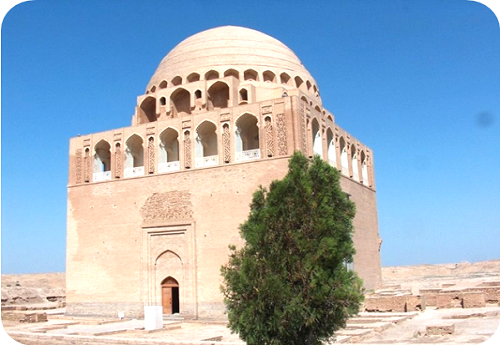
Sultan Sandzhar Mausoleum is most majestic architectural monument of mediaeval Merv. Located in the center of Sultan Kala. In the architecture of the mausoleum, amazing harmony, symmetrical proportions, perfection of details and amazing completeness of composition are striking. The building is strictly centric, which is generally characteristic of the Khorosan types of mausoleums. The square building (with a side of 27 m) has a single square room in size of 17x17 m, developed by four arched niches in the thickness of the walls. It is covered by a high dome on a system of arched sails, which, with the help of four-tier stalactite sails of a sixteen hexagon, create a support ring of the dome. The plain truth is that the mausoleum of Sultan Sanjar was built in the very middle of the XII century and since then it has amazed humanity with its majestic beauty.
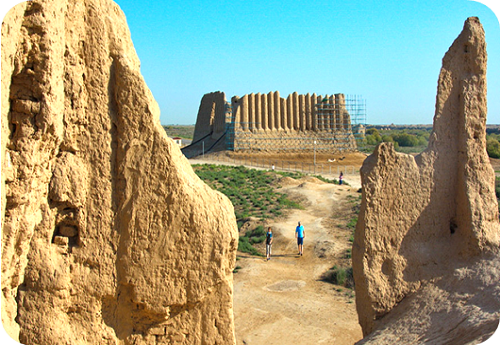
Major Gyz-Kala - medieval kyoshk castle, that has preserved the correctness and severity of forms to this day, although it was created by architects from adobe bricks - a material not particularly durable and not designed for an exam. In plan, it has a rectangle with sides 42,2x37,2 m. Its walls are preserved to a height of 15 meters. Its northern and western walls have weathered and lost relief, while the other two facades delight with the powerful corrugation made up of four to five-sided half-cylinders. Now Gyz-kala is in scaffolding, research and restoration is underway so that this medieval castle-fortress reveals all its secrets to present generations and is preserved for future generations as a vivid example of architecture.

Astana-baba is located in Kerki district. The mausoleum of Astana-baba is a 11th - 12th-century monument of architecture. In total, under the arches of the mausoleum there are five tombs that appeared in different years. The local population it is exactly mazar Astana-baba, the mausoleum of Ali Zaid brothers and Zuveyd Ali mausoleum and their wives - Kyzlyar Bibi. Very late is considered an extension room "Gyzlar Bibi", referring to the XVIII century, which is very popular among women pilgrims. In the ensemble of the Astana-baba mausoleum, an extraordinary grouping of four dome volumes, combined into a single system by entrance structures, attracts attention.
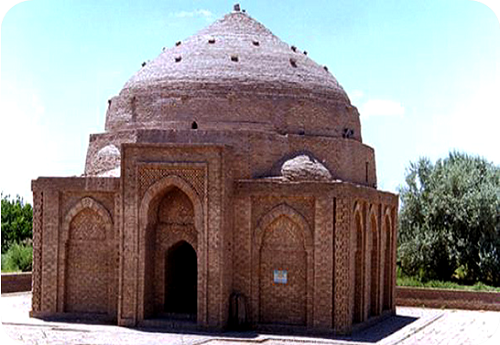
Allamberdar Mausoleum is the largest among the existing early structures of Northern Khurasan. is an 11th-century monument of architecture. Inside the mausoleum there is only one room with a false gravestone - the archeologists have not found any burials under and around the monument. This is a large building, square in plan, with a room covered by a dome on arched sails. The facade of the mausoleum is richly decorated with a nornamental laying with fancy carved little bricks. The corners are fixed with octagonal pillars. The entrance is underlined by a small portal with arched ornamental niches on the sides.
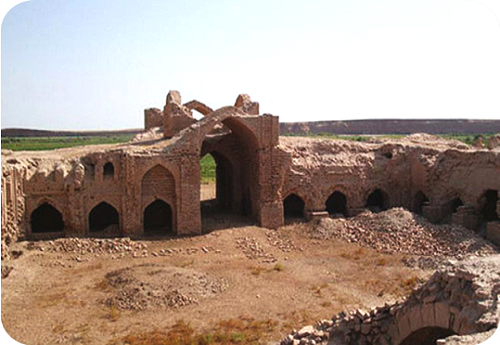
Dayahatyn - the caravanserai is located on the road leading from Turkmenabad to Khorezm. This structure is located inside defensive wall of fortress built by Tahiriy and acts as a typical example showing the mastering
skill of Seljuk architects on brickworks during the 11th and 12th centuries. The caravanserai has a symmetrical square layout, a 4-aivan courtyard with a covered vaulted. Caravanserai is located on the road leading from Turkmenabad
to Khorezm. This structure is located inside defensive wall of fortress built by Tahiriy and acts as a typical example showing the mastering skill of Seljuk architects on brickworks during the 11th and 12th centuries. The caravanserai
has a symmetrical square layout, a 4-aivan courtyard with a covered vaulted.

Parav-bibi is a small mosque located near the city of Serdar, Balkan region, and is a sacrosanct place for all Muslim women. There is a legend that villagers wanted to pay off the enemy by giving him their healer-girl.
With pain from betrayal, Parav-bibi escaped, and walled herself alive in a cave.
Later, people built a small white mosque here. A winding staircase leads to a sacred place. Thousands of women and young couples come here.
They ask for health, for blessing, for the birth of a child. In addition to the mosque, according to legend, the rocks left imprints of the healer’s knees, elbows and forehead; as well as petrified pieces of melon thrown by the
girl towards the enemies.

Shibli-baba or, also called, Shyvlan – is whole ritual complex, that has developed at the foot of Mount Sint Hasar. The main feature of Shyvlan is the high mountain slope hanging over it, completely covered with dark lichens. Shibli Baba was considered the patron a saint - the patron saint of the insane. This picturesque corner of the nature of Western Kopetdag can rightfully be called miraculous, people attribute to it magical power. This is clearly evidenced by items left by pilgrims on sacred tree branches and shrubs.

Gozli Ata is one of the most remote pilgrimage sites in Turkmenistan. Its strusture is also one of the most beautiful. It lies in the center of a natural bowl surrounded by protrusions of strips of pink and white stone.
Reportedly, Gozli Ata was a respected Sufi who lived at the beginning of 14th century. Its mausoleum is a brick building with two white domes, standing in the old cemetery with many beautifully carved stone tombs. The two-headed
structure of the mausoleum is necessary to accommodate the length of the tomb: a triangular prism, possibly three ordinary graves long.

Darvaza Gas Crater (Garagum Yalkymy) - Darvaza Gas Crater is located in Turkmenistan in the very center of the Kara Kum, one of greatest deserts of Asia. (latitude -40.252324, longitude -58.439843) Imagine a crater
with a diameter of 60 and a depth of 20 meters, blazing with hundreds of torches, buzzing and full of hot air. Gas rushing from the pores of the earth, dividing into hundreds of burning torches of different sizes. In some torches,
flames reach 10-15 meters in height.
Darvaza Gas is located in 266km to the north of Ashgabat city and in 90 kilometers north of the village of Yerbent.

Ismamut-ata - late medieval architectural complex in 12 km to the south of Takhta (Дашогузский велаят). It has been constructed on the ruins of the medieval settlement of Eshretkala. (X-XI вв.), there are several
sacred burials in the complex, surrounded by a large graveyard. Pilgrims come to the mausoleum of Isym (Isym Mahmut Ata), but this mausoleum dates from the 18th century. It is the latest building. The mausoleum is well preserved.
At the entrance, the names of the masters who created it are engraved. Memorial rooms and the mosque are decorated with beautiful carved wooden pillars.
It is noteworthy that for students and pilgrims a hotel was built on
the territory of Ismamut-Ata.

Mausoleum of Tyurabek-khanym
Tyurabek-khanym was a real historic figure, a Mongolian princess, the favorite daughter of the governor of Golden Horde - Uzbek-khan and the spouse of his deputy in Khoresm Kutlug
Timur. Tyurabek - khanym was the patroness of women. Eventually she was canonized and declared a saint. Amazing in its beauty and grace, it is the structure with the richest interior and exterior finish, with surprisingly open
and light hexagonal hall with the area of about a hundred square meters, decorated with carved mosaic. It was crowned with a huge dome. The dome is tied on the top according to the tradition of that time.
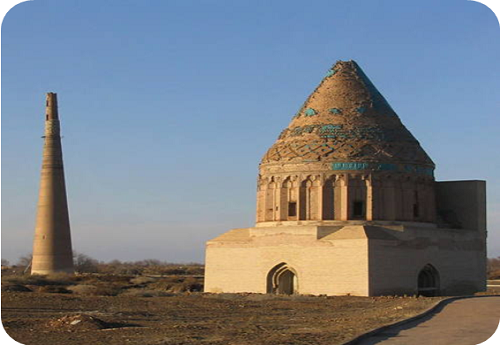
Minaret of Kutlug-Timur 60 - meter high minaret of Kutlug-Timur is the highest monument in Central even in comparison to the mausoleum of Sultan Sandzhar. The minaret is shaped like a conic column. Slim tapered circular
trunk is divided by eighteen belts (strips) painted by an ornament and three belts of inscriptions in Kufi. In the past the minaret had a wooden Iranian lantern which had burned during a fire. To get to the top you would use
a spiral staircase of 145 steps but the staircase was only accessible from the roof of the mosque which does not exist any more. The Minaret of Kutlug-Timur is deprived of the rich decor of Central Asian minarets of the 11th-12th
centuries, but it surpasses them due to its boldness of design.